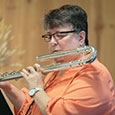Bizet’s Minuet from L’Arlesienne Suite No. 2 is a classic gem that is well worth exploring. Whether you are planning to perform it for the first time or are revisiting it for an audition, there are many interesting musical and technical characteristics to note. Because this piece is often used for orchestral auditions, students should take the time to learn it well.
Georges Bizet (1838–1875) was born into a musical family and entered the Paris Conservatory of Music at the age of ten. He studied piano, organ and fugue/counterpoint there and began to seriously compose when he was 17. Two years later, he won the prestigious Prix de Rome which gave him the opportunity to study in Rome for three years. On returning to Paris, he composed instrumental music, but soon ventured into the operatic world. Bizet’s best known work is the opera Carmen (1873).
In 1872, Bizet composed incidental music to Alphonse Daudet’s play L’Arlesienne (The Girl from Arles). The incidental music included 27 pieces of varying lengths scored for voice, chorus and small orchestra. Even though the Paris reviews of the music were poor, Bizet reorganized the music into Suite No. 1. In 1879, four years after his death, Ernest Guiraud arranged and published Suite No. 2. Not all the music in Suite No. 2 was from L’Arlesienne as the famous Minuet was actually written for Bizet’s earlier opera The Fair Maid of Perth. The Minuet is scored for orchestra with prominent solos for the flute and harp. The version with piano accompaniment that many students play is based on a reduction of the orchestral part.
The Bizet Minuet is a French dance in 3/4 meter and ABA form. The first section is written in E flat major, the second is in A flat major, and the third section returns to E flat major. The tempo marking is Andante quasi allegretto (A walking tempo somewhat on a brighter side). While a metronome marking is omitted, quarter = 72-80 is a good performance tempo. If played any slower or any faster, the Minuet loses its dance feel. The piano accompaniment begins pp with a two-bar eighth-note arpeggiated E flat major chord. Count 1+2+3+ during the initial two bars so you enter at the correct tempo.
Practice E flat and A flat major scales and chords (especially broken arpeggios, slurred) before playing this piece. Reviewing the descending chromatic scale is also an excellent idea. Use a tuner and metronome.
Mark your breathing places even before you play the first note. Consult the piano part and look at chord changes and the bass line to assist in your choices. Take a breath at each rest. Younger players should look for plenty of breathing spots. Your breathing capacity will diminish under stress, so plan now for recital breaths.
Observe performance marks carefully. Notes with both a slur and a staccato are played tenuto. The accents in the B section of the piece are actually called little diminuendos. They should be played as if you are saying the word Die, Die, Die. The first note of a two-note slur is played stronger than the second note. Adding some color vibrato to the first note of a slur will enhance your presentation.
Notice the slash on the stem of each grace note. The slash indicates the grace note is an acciaccatura (to crush) and should be played before the beat but as close to the beat as possible.
Carefully follow the written dynamics and performance indications. Bizet really means it when he writes crescendo molto, calando, smorzando, and longa. If you do not know the definition of these words, look them up in a music dictionary and write the definitions in pencil in the music.
Notice and enjoy the counter melody at measure 56. Although the flute plays a repeat of the melody at measure 11, Bizet incorporates a duet part in the right hand of the piano part that weaves in and out of the flute solo. To beautifully taper the final note ppp, move your lips forward and use a smaller lip (aperture) opening. Remember to keep the air stream moving.
My final recommendation is to memorize the composition. Flutists of all ages and levels can easily identify and learn how this solo is constructed. Playing this piece by memory will go a long way toward mastery of this piece and more. You will gain confidence to challenge yourself to learn and memorize whatever is coming next on your path toward excellence.
Check out the Flute Talk Classic from 1982 – with some further suggestions on the Minuet for more advanced players by Walfrid Kujala.






